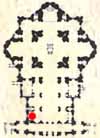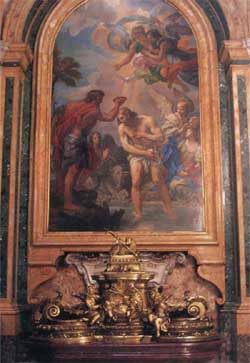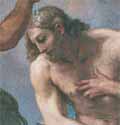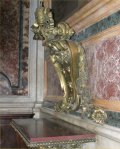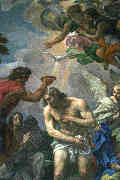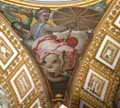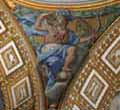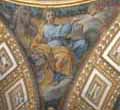| Grottoes
Vatican City Colonnade Saints Floorplan #2 |
| Altars
Monuments The History |
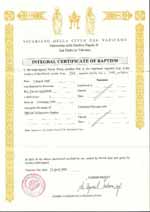
Baptismal Certificate
from St Peter's

John Paul II Coat
of Arms
Baptistery Floor

Baptistery Alterpiece
Mosaic Detail
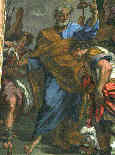
St Peter Baptising
Centurion
Left Wall
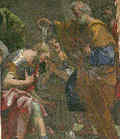
St Peter Baptising
Processo and Martiniano
Right Wall
From:
'St. Peter's - Guide to Basilica and Square'
Thus we reach the last chapel in the left aisle. It is the Chapel of the
Baptistery, one of the basilica's most beautiful chapels and built after
a design by Carlo Fontana (1634-1714). In the center is the baptismal
font, still used on Sundays to administer the sacrament of baptism.
The original 5th century font, which dates back to Pope Damasus, was replaced by a sarcophagus used as a font, and then in the 17th century by the present day font whose red porphyry basin was made from an ornament on an ancient pagan sepulcher, later used to cover the sarcophagus of Otto II who died in 983. The Rococo cover in gilded bronze with volutes and cherubs, dominated by the Lamb of God, is the work of Giovanni Giardoni. In the forepart, two bronze angels bear a relief of the Most Holy Trinity and a geographical representation of Italy.
The altarpiece in mosaic was made in 1722, reproducing a design by the painter from the Marches, Carlo Maratta, which dates to 1696-1698. It represents the Baptism of Jesus by John the Baptist, in the River Jordan.
Beside the chapel are another two mosaics: on the right, St. Peter baptizing the Centurion Cornelius inspired by a painting by Andrea Procaccini, executed in 1711; and on the left, St. Peter baptizing Sts. Processus and Martinian, his two fellow-prisoners, after a painting by Giuseppe Passeri.
The dome is decorated with mosaics, from originals by Francesco Trevisani da Capodistria. In the spandrels are portrayed the races of the four continents which became Christian: Europe, Asia, Africa, America. In the lunettes are various baptismal scenes: Jesus baptizes Peter, St. Peter baptizes the Centurion Cornelius, St. Philip baptizes the Eunuch of Queen Candace, St. Silvester baptizes Constantine, and several symbols of baptism: Moses causes the water to spring from the rock, Noah prays before the rainbow of the Covenant.
In this chapel, on October 16, 1994, Pope John Paul II's new coat of arms was set into the marble pavement in the center of the chapel. Against the lapis lazuli background of the escutcheon, the bars of the cross and the letter "M" (for Maria) stand out clearly in giallo antico The keys, miter and infulae stand out against the black French marble. The letters of the motto: "Totus tuus", in giallo antico are inlaid in green serpentine which borders the black background at both sides.
Spandrels (1709-1726), from designs by Francesco Trevisani (1656-1746)
From:
'St. Peter's Basilica - A Virtual Tour' by Our
Sunday Visitor
Finally, we arrive at the Baptistery Chapel, where the guiding theme of
the mosaic decoration is the administration of the Sacrament of the Holy
Font. The mosaics in the cupola show the triple Baptism with water, by
St. John the Baptist; with blood, of the martyrs; and with desire, of
the multitude eager for the purifying bath.
In the lunettes we can admire the Old Testament prefigurations and the first famous Baptisms: Noah contemplating the rainbow after the flood, a sign of the alliance between God and man; Moses drawing water from a stone, savior of bodies but not yet of souls; Christ baptizing St. Peter; St. Philip baptizing the eunuch of Queen Candace; St. Silvester baptizing the Emperor Constantine.
The corbels show the effects of the regeneration of Baptism performed in the four corners of the world: Europe with the papal tiara, America girded with feathers and a quiver, Africa with an elephant and Asia with a thurible.
The original drawings were by F. Trevisani who was one of the leading exponents of late Baroque painting in Rome in the early decades of the 18th century. N. Ricciolini supervised G. Brughi, L. Fattori and others in the translation into mosaic, certainly one of the best with regard to the rendering of the colors and of the plastic-design effects.
In this Chapel too, as Galassi Paluzzi also points out with regard to others, in the tambour are four statues not normally mentioned in guides, not even in the very accurate one by Turcio.
In this sumptuous Chapel, designed by C. Fontana, are three altarpieces, which are quite typical of Maratti's school, already mentioned before. In the center is the Baptism of Jesus by C. Maratti and helpers, now in Santa Maria degli Angeli, transformed into mosaic in 1722 by Cristofari.
On the right is the Baptism of Sts. Processo and Martiniano by G. Passeri and on the left is St. Peter baptizing the Centurion Cornelius by A. Procaccini, both successful pupils of the Maratti. The subjects are two fundamental episodes in the life of St. Peter, chosen to underline the two similar attitudes of Peter and Paul toward the people.
In the middle of the Chapel is the magnificent baptismal font, commissioned in 1692 from Fontana himself, who completed it in 1698, after a difficult preparation (his first project was refused because it was too large and too expensive). It is made up of a rich bowl in red porphyry measuring 4x2 meters, of uncertain origin while definitely pagan, previously used as the cover of the sarcophagus of Emperor Otto II, who died in Rome in 983.
Upon it has been placed a superb gilded bronze cover, designed by Fontana and crafted by G. Giardini, completely decorated with foliage and arabesques. It is surmounted by a mystic lamb, and on the front bears a medallion showing the Holy Trinity blessing the world, supported by two angels; the angels are by Pigers and the Agnus Dei by Tedeschi.
Until 1694 the sarcophagus of Anicius Sestus Petronius Probus, prefect of Rome in the fourth century, now in the Grottoes, had been used as the font. It had been in the Old Basilica, placed there in the mid 15th century by Nicholas V, to replace Pope Damasus' early font which was no longer usable.
At the sides of the Chapel, there are two elegant porphyry brackets bearing the Pignatelli coat of arms of Pope Innocent XII which are worth admiring as they are true jewels of applied art. As Galassi Paluzzi points out, this Chapel symbolizes the Precursor of the Christ, corresponding to the one opposite in the right aisle symbolizing his Mother. In this way, the two great sources of health, blood and water, are represented one at the entrance to and one at the exit from the Basilica.
From:
'THE NEW SAINT PETER'S'
The Chapel of the Baptistery is the first on the left as one enters the
body of the church. It is large, with an elliptical cupola, conceived
by the great Lombard architect Carlo Fontana (1634-1714), with a stylistic
autonomy which nevertheless conforms well to the structure of the Basilica.
The mosaic decoration of the cupola contains references to the theology
of baptism. In the basin of the cupola we see the triple baptism of water,
of blood, and of desire (the last symbolized by Saint John the Baptist);
in the corbels are the parts of the world which have accepted baptism.
The mosaics are by F. Trevisani.
The basin of the font is the cover of a large sarcophagus said to have contained the remains of Otto II (973-983). The tomb of the Emperor was situated in the portico of the old Basilica, as Christians then, great and humble, all desired: to rest near the tomb of Saint Peter. The surrounding mosaics are by Maratta del Passeri and by Procaccini, that is, by the best mannerist painters of the 18th century.
From: 'Guide to
St Peter's Basilica' © 2003, Libreria
Editrice Vaticana
When the Cathedra of St Peter was moved from this chapel to the monument
in the apse of the tribune, Innocent XII Pignatelli (1691-1700) ordered
the Baptismal Font placed here.
It is the work of Carlo Fontana. The area where the baptismal font is placed is fenced by a broccatello balustrade and inside there are three mosaic altarpieces. In the center, Jesus' Baptism by Carlo Maratta, the original painting is in the Basilica of St Mary of the Angels. To the right, St Processes and Martinian's Baptism by Giuseppe Passeri, and to the left St Peter baptizing the Centurion Cornelius by Andrea Procaccini.
In the center of the chapel is the Baptismal Font commissioned to Carlo Fontana in 1692 at the end of a competition in which more than 20 of the most famous artist of that age took part. The work was realized after a suffered project (a first drawing had been refused because it was considered too bulky and expensive).
Fontana reused a rich red porphyry basin (4m x 2m), of pagan origin, believed to derive from the tomb of Emperor Hadrian (Castle San Angelo), then used to cover the sarcophagus of Emperor Otto II, who died in Rome in 988 and was buried in the atrium of the ancient Basilica.
The gilt bronze covering was planned by Fontana himself and realized by Giovanni Giardini. Over it is the Agnus Dei, symbol of the Redeemer Christ, by Lorenzo Ottoni. The front medallion represents the "Holy Trinity blessing the World", with two angels at the sides, modelled by Michel Maille.
From:
Catholic Encyclopedia - Carlo Fontana
By order of Innocent XI he wrote a diffuse description of the Templum
Vaticanum (1694). In this work Fontana advised the demolition of that
nest of houses which formed a sort of island from Ponte Sant' Angelo to
the piazza of St. Peter's. Fontana made a calculation of the whole expense
of St. Peter's from the beginning to 1694, which amounted to 46,800,052
crowns, without including models.
